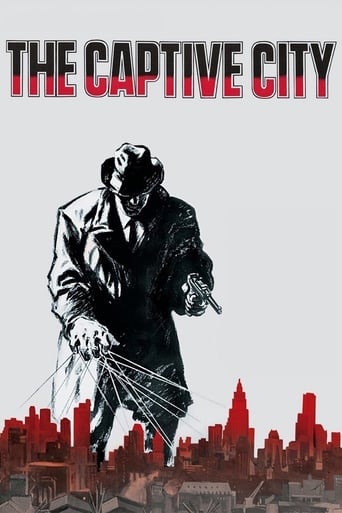christopher-underwood
Robert Wise directs but without much enthusiasm and Lee Garmes, the cinematographer has little opportunity to show his skill. Indeed, this little B movie, I hesitate to use the much overused 'noir' tag, is most uninspired. Prompted, apparently, by the real life Senate Committee on organised crime and even sporting an afterword by the real life head of that committee, Senator Estes Kefauver, urging American citizens to play their part in stamping out such crime in their neighbourhoods, this still lacks a bit of 'life'. John Forsythe doesn't help with a lacklustre performance as the lead and Joan Camden even less so as his wife. The thing here is that this was clearly intended as a well meaning do good kind of a film, setting out the problem and urging everyone to help solve it. To help things along at one point the wife asks her husband, 'What is the mafia?' so there's little doubt at what level this film was aimed. Competent but far too uninteresting a story and with no violence the 'real life' message is about all this has.
dougdoepke
When newspaper editor John Forsythe and wife rush into the police station with an urgent tale told in flashback, I thought Invasion of the Body Snatchers (1956). In fact, there are a number of similarities between the two films. Here, however, the menace is not seeds from outer space but plain old organized crime. The story is told in grippingly fluent fashion by versatile director Robert Wise. I really like the way the film uses unfamiliar faces in the important supporting roles, giving the docu-drama a more authentic appearance.Actually, the movie is rather educational since it reveals the various pressure points within a community where criminal influence can make a difference. Note how newspaper policy can be manipulated by advertising revenue; how church involvement can be influenced by congregation size; how police policy can be set by civic elders instead of the law. That is the point of the movie-- to show how a community can be corrupted by exploiting these various pressure points. At the time (1951), the Kefauver Committee on Organized Crime was making national headlines, accounting for the Senator's public service epilogue.Surprisingly for a crime drama with noirish overtones, the violence and menace are mostly understated. Menace consists mainly of warnings to crusading editor Forsythe from ordinary-looking people. For me, however, the scariest part was neither the beating nor the hit-&-run, but the sudden transformation of affable used car salesman Andy (Jess Kirkpatrick). In social scenes showing the town's normality, Andy comes across as the typical friendly, outgoing salesman, but later, when the pressure's on, he slides into a startlingly sinister personality-- one of the many parallels with Body Snatchers. Filming on location in grainy black&white amounts to a real plus for an authentic feel. Forsythe and Camden are excellent in their central roles, without going over the top. There's a low-key intensity to the narrative that rivets interest, but never reaches the emotional pitch of the sci-fi classic. In my book, this is one of those polished little B- productions that Hollywood used to turn out with some regularity. Too bad that they have no counterpart in today's over f-x'ed cinema.
MartinHafer
John Forsythe stars in this excellent crime drama directed by Robert Wise. Unlike most movies involving the mob, this one is quite a bit different, as you never actually get to see many of the crooks and the menace is much more implied than actual. This isn't bad, as it makes the film seem less predictable and more realistic.Forsythe is a newspaper owner in a small town where you'd never expect the mob. When a local private detective comes to Forstythe with stories of mobs and payoffs, the newspaperman can't believe it and only does a cursory investigation. But, when a bit later this detective is killed, Forstythe starts to wonder if there really is more to the story. Unfortunately for him, when he digs deeper, he puts his life on the line as well.Senator Kefauver (who made a name for himself crusading against organized crime) gives an epilogue in which he says the story is true. I'd really like to know more, though IMDb doesn't have any information about the case. If anyone can give me more info, I'd appreciate it.
RanchoTuVu
John Forsythe plays a small city newspaper editor in this in this humorless depiction of corruption and vice in paranoid post WW2 America. At one point, after discovering that the chief of police (Ray Teal) is going to cave in to the mob, he's reduced to beseeching the town clergy, as if they could stop the incipient corruption taking place under their noses. With a couple of convincing murders to give the film a modicum of tension, most notable being that of private eye Clyde Nelson (Hal K Dawson) who gets backed into a dead end street and then smashed by a Buick (I believe), the picture manages to convey a diminished essence of the threat the poor town is facing. Mostly though, we're taken on a moral crusade, which in the end goes to a US Senate hearing chaired by Estes Kefauver, who tries to give the film some more weight with an epilogue in which he assures us that the real life editor is alive and a credit to his profession. Directed by Robert Wise, this is no "The Set Up", but a borderline trite piece of pro-government Hollywood propaganda which has as its main villain a Jewish insurance broker (Murray Searak played by Victor Sutherland) whose small time numbers racket gets taken over by the Mafia, who are doing the same thing in countless other endangered smallish American cities of 30,000 or so. Some effective photography and a brisk pace that goes nowhere tend to keep you watching all the way to the disappointing finish.





